Experiences and Cultural Atractions in Tanzania
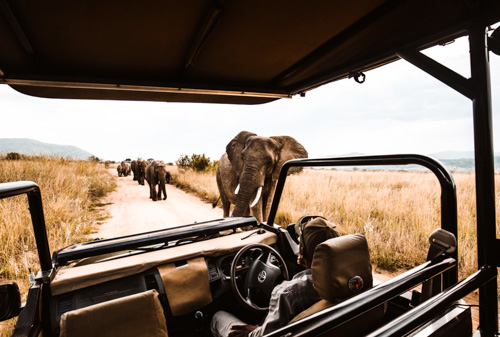
Tanzania trips offer an incredible variety of highlights. The Serengeti National Park and the Ngorongoro Crater are world-famous and offshore islands such as Zanzibar, Pemba and Mafia offer a perfect safari and beach combination.
Travels to Tanzania are impressive, as no other country in Africa can offer such a variety and large population of wildlife and incredible natural places
Browse through our platform to find your dream experience, or contact us to help you design your perfect Tanzania trip
Climb the Kilimanjaro
The roof of Africa - Kilimanjaro has fascinated for centuries.
Make your dream come true and climb Kilimanjaro in Tanzania. With 5895 meters the highest and most famous peak in Africa. Although Kilimanjaro is almost 6,000 meters high, you don't need to have any mountaineering skills to climb it..
A good physical fitness, an average condition, a strong will and of course a bit of luck are sufficient to reach the summit.
The equipment depends primarily on the travel time, type of travel and destination. The assumption that it is always warm in Africa and that the sun always shines is deceptive. Especially in the mountainous regions, such as on Kilimanjaro, in the Ngorongoro area or in the Usambara Mountains, it can get very cold during the summer months.
For trekking trips and mountain climbs above 4,000 m (Mount Meru and Kilimanjaro) complete trekking equipment for high mountains is required, as well as warm clothing and sturdy shoes are essential.
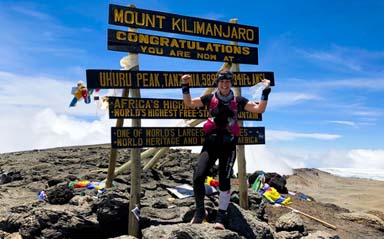

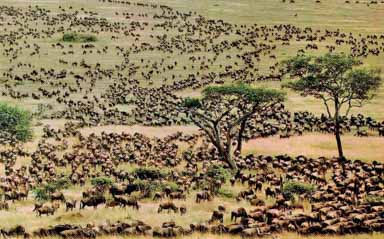
Experience the Great Migration
Every year at the same time it happens again: driven by the age-old rhythm of the life cycle, more than one million wildebeest, 200,000 zebras and 300,000 Thomson's gazelle set themselves in motion. They are accompanied by hungry cats of prey across the open plains and through crocodile-laden waters.
Their destination: the fresh grazing grounds in the north, where the species regenerates in a short time and around 8,000 calves are born every day, before the 1,000 km long and exhausting migration starts all over again.
The migration takes place periodically in a clockwise direction between the pastures of the Serengeti in Tanzania and the Masai Mara Reserve in Kenya - a distance of almost 3,000 km.
The Serengeti and Masai Mara belong to the same ecosystem. The animals, however, naturally know no national borders and move to those places where they find food and water. They often migrate in groups of up to several thousand animals, which travel together along the migration route. However, it is also quite normal that some groups deviate from the "normal" route.
Here is a brief outline of the Great Migration:
January-March: Birth Season
Within two to three weeks, over half a million gnu calves are born. At the peak of the calf season, up to 8,000 calves are actually born each day. The small gnu calves get up quickly and are integrated into the herd just as quickly - if they don't fall victim to predators such as lions or leopards.
April-July: Migration north
This is the raining period and it can be difficult to observe the migration as during other seasons.
July-October: The crossing of the river Mara
To get to Masai Mara in Kenya and to the fresh grass, the herds have to cross the river. The crossing is one of the highlights of the great migration. Crocodiles lurk in the river, hunting for the many prey animals as they cross the river. A dramatic fight for survival begins.
November-December: Hike south
After crossing the river back to Tanzania, the herds start again to migrate south through the Serengeti National Park.
Around December/January, the herds will be back approximately where they started their migration. The veal season starts again.
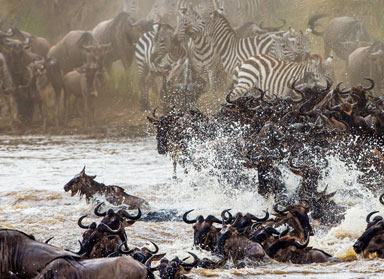

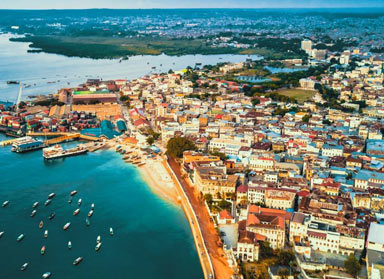
Go back in time in Stonetown
The weather-beaten walls of Stonetown tell the most varied stories of days gone by. Winding alleys, an anglican cathedral, Arabic houses, fairytale palaces and colourful markets bear witness to its ever-changing thousand year long history. Besides paradisiacal dream beaches Zanzibar has another tourist magnet with Stonetown. You should definitely visit some of the sights:
Arabic fort: The Arab Fort is located directly behind the Forodhani Gardens, the promenade of Stonetown. The fort was built in the years 1698-1701. Over the centuries it often changed its purpose and was used as a prison, market place or even as a tennis court. Since 1994, the large amphitheatre has been used as a venue for larger events.
Sultan's Palace: Stone Town, Zanzibar Sultan's Palace, which has housed the "Palace Museum" since 1994, is located immediately to the left of the House of Wonders. From 1834 to 1964 it served as the seat of government and residence of the ruling Sultan. Since the fall of the last Sultan Jamshid in 1964, the palace was used by the government for administration.
The magnificent rooms of the palace are filled with the gifts of former heads of state from all over the world. The life story of Princess Salme, who married a German businessman in 1868, is also interesting.
Anglican Cathedral: Old Slave Market, Stone Town, Zanzibar Anglican Cathedral of Zanzibar was built 1873-1880 by the "Universities Mission" of the famous David Livingstone and the British Bishop Edward Steere on the former slave market. When David Livingstone came to Zanzibar in 1856, he began - horrified by the inhumanity - to exert political pressure on the Sultan through influential friends, among others, who finally banned the slave trade on 6 June 1873. At the place where the altar stood, there is said to have been a tree to which the slaves were chained for sale. In the cellar buildings next door, you can visit the rooms of former slave quarters.
Book a stay at this remarkable place, as a perfect extension to a safari & wildlife itinerary.
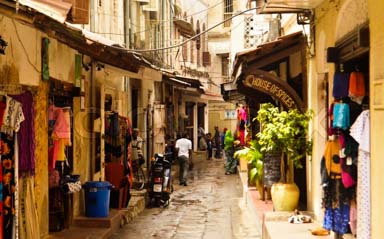

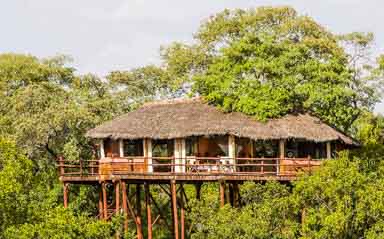
Sleep in the Treetops of Tarangire
The Tarangire National Park is with 2.850 km² the sixth largest national park in Africa. It is home to one of the largest elephant herds in Africa (and the largest in northern Tanzania) with up to 2,500 animals, 550 different bird species, tree-climbing lions and pythons! One of the landmarks of the reserve are the fabulous tree house lodges. Enjoy a night in one of the most special accommodations in Africa.
In the treetops, you will spend the night on 65 square metres, including an en-suite bathroom with an exotic double shower. The furnishings are adapted to the surroundings and local craftsmanship gives the interior an authentic flair. The private terrace overlooks the Tarangire National Park and you can listen to the wild sounds of the area. After a day in the wilderness, relax by the pool and in the evening enjoy an excellent dinner by lantern light - this is where children's dreams come true!

Swim with the Dolphins of Pemba Island
The island of Pemba enjoys far less attention than the world-famous main island of Zanzibar and has therefore been able to maintain a peaceful and endearing atmosphere between spice and fruit trees. Its original landscape with its irregularly shaped coast and dense mangrove forests are dominated by steep slopes and deep valleys in many places. Due to its four million clove trees, some of which are over 100 years old, Pemba is also known as the clove island of the Indian Ocean.
You can experience the intelligent, happy and playful sea mammals up close on one of our many island tours. But not only dolphins make a trip to Pemba Island worth your time. Fertile hills, smaller offshore islands and a number of excellent diving areas await the explorer north of Zanzibar and enable him to spend peaceful holidays in a lovely atmosphere.
Apart from swimming with dolphins, possible activities on Pemba Island include: Snorkelling and diving; Sailing; Safari on Mesali Island (marine reserve with a wide range of marine life; Trips to the natural rainforest "Ngezi Forest; From December to February: Whale Watching
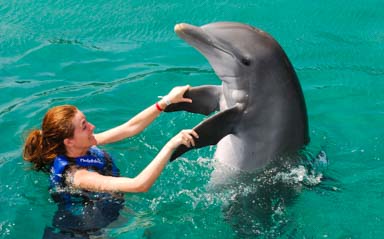

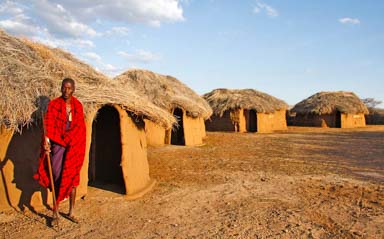
Visit a Maasai Village
They immigrated along the Nile from Sudan and Egypt from 1550 onwards, bringing with them knowledge of agriculture and livestock breeding. In the 18th century, the Masai were feared as "wild barbarians"; their territories were shunned by Arabs, mountain peoples and Europeans alike. Due to drought, cattle plague, epidemics and civil wars the Massai lost land, livestock and prosperity in the 19th century.
The 140,000 Maasai in Tanzania lives mainly in the area around Arusha as well as in the Ngorongoro Conservation Area and in the Serengeti. Most of them already live as semi-nomads in a kraal (enk-ang) and only change places every few years, depending on the fertility of the landscape. Besides animal husbandry, the men now also earn their income as night watchmen or doormen (askari). More and more Massai send at least one of their children to school. During school time the young Massai wears jeans, sneakers and T-shirts and report to the tribal elders by mobile phone.
But still, you can come and visit an authentic Maasai village and take part in their cultural ceremonies.

A Visit to the Red Lake
The extreme north of the country is shaped and characterized by volcanoes. At the foot of the cone mountain Ol Doinyo Lengai lies the shallow, soda-rich Lake Natron in a dry, dusty scree desert. This region is considered to be a land of bizarre beauties such as the active volcano Ol Doinyo Lengai (which translated means "The Mountain of God"), the shimmering Lake Natron, the rugged East African Rift Valley and the endless sand and stone deserts.
It has only a few inflowing streams and not a single outflow. During and after the rainy season, rivers from the Ngorongoro Highlands and the hills of the Crater Highlands feed the lake. Therefore, its surface area varies between over 1000 km² at the end of the rainy season and a few square kilometres towards the end of the dry season.
The pinkish-red colour of the lake, which is only visible seasonally, is caused by unicellular algae, the spirulina. These algae, which are mixed with purple bacteria, are not only responsible for the partial colouring of the lake, but also for the characteristic colouring of the dwarf flamingos, whose natural habitat forms this otherwise hostile environment.
About 2 million lesser flamingos stay at the lake during the high season. Here the birds can nest and breed without fear of their hunters. Lake Natron is, therefore, one of the world's largest breeding areas for Lesser Flamingos. The elegant animals filter the water through their sieve-like beak and thus collect the algae contained in it.
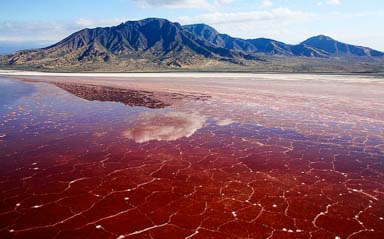

Activities in Tanzania
WILDLIFE SAFARI
GAME VIEWING
TREKKING
PHOTOGRAPHY
SURFING
CAMPING
CANOEING
FISHING
SCUBA DIVING
CULTURE-TRAVEL
TANZANIA CULTURAL INFORMATION
- PEOPLE:
Tanzania is a multi-ethnic state with more than 130 ethnic groups, which are characterized by their different cultural forms, beliefs, traditions and partly also different languages, but almost all of them (95%) can be assigned to the Bantu ethnic group. The largest Bantu peoples of the country in terms of number of members are the Sukuma (12 %), followed by the Nyamwezi (9 %), the Hehet/Bena (8 %), the Haya (7 %) and the Swahili (6 %) on the coast. The best known ethnic group, the Massai, make up about 3 % of the population. - FOOD:
In the cuisine of the interior of Tanzania, it is mostly corn porridge ("ugali"), plantains, beans and spinach that are served. As an essential part of the Tanzanian cuisine, ugali serves as a side dish to meat and stews. Most of the dishes of Tanzanian cuisine are rich and greasy, because often the main purpose of eating is to get full. Next to that, bananas are prepared in Tanzania in many different ways: roasted, fried, fried, grilled or as a porridge. - LANGUAGE:
Kiswahili, the lingua franca of East Africa, is the official language of Tanzania and forms a unifying bond between the tribes. English, the administrative language of the British colonial era, is no longer spoken in the civil service, in parliament or in government, but is still considered the language of the courts and thus an official language in the broadest sense. - CURRENCY:
The currency in Tanzania is the Tanzanian Shilling. Foreign exchange can be exchanged in banks or exchange offices. US dollars are recommended to take along. So you should carry US dollars in cash for the payment of visa, departure taxes and other fees. Good to know: Only dollar notes with a large presidential head, printed from 2006 onwards, are accepted in Tanzania (only one-dollar notes with a small head are also acceptable). Cash can then be exchanged for the national currency on site.
Know before you go
- GETTING THERE:
The international destination airports of Tanzania are Kilimanjaro International Airport, Dar es Salaam and Zanzibar. The Kilimanjaro Int. airport is the optimal starting point for Kilimanjaro ascents and safaris in the north. These include trips to the Serengeti National Park, Ngorongoro Crater, Lake Manyara National Park, Tarangire National Park and Arusha National Park. These airlines fly to Kilimajaro International Airport: Ethiopian Airlines, Condor and KLM. - SAFETY:
Tanzania is, due to its political stability, one of the safest East African travel countries. But of course, there are also security gaps in Tanzania due to widespread poverty, such as theft and robberies. You should never openly show what you own and in terms of valuables, it is better to carry banknotes individually and in small quantities in your trouser pocket or similar. All in all, Tanzania is safe and it should not be a concern before your trip. - HEALTH:
There are no compulsory vaccinations for direct entry from Europe or America. When entering the country from a yellow fever area (e.g. neighbouring countries), proof of a valid yellow fever vaccination from the age of 1 year is required. Before you start your journey you should have your immunisations against tetanus, diphtheria and poliomyelitis (polio) checked and, if necessary, refreshed. Malaria is widely spread. Thus, good mosquito protection and malaria prophylaxis is recommended. - VISA AND PASSPORT:
The visa can be applied for at the Tanzanian embassy three to four weeks before departure (approx. 50 EUR plus postage), or alternatively it can be obtained on arrival in Tanzania (50 USD, to be paid in cash on-site). We recommend this variant, it is less complicated and cheaper. Please always be up to date with the newest requirements on the government's immigration website.
 Book Now!
Book Now!




